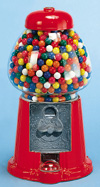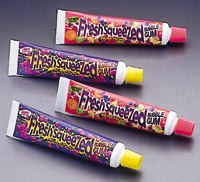
Today's chewing gums--made mostly of synthetic materials--have evolved into colorful novelties of all shapes and sizes as well as more serious functional products that claim to help adults cope with modern problems. This requires product developers to blend technical know-how with psychology, art and creativity.
"As developers of novelty gums and candies, we are asked to find the answer to an impossible question," says Chris Corriveau, vice president, R&D, Amurol Confections Co., Yorkville, Ill.
Although traditional mint-flavored gums and bubble gums remain popular, today's chewing gums are following several key trends such as intense flavors, sourness, sugarless gums, and functional gums.
Chewing Gum Basics
Scientifically speaking, chewing gum is a semi-crystalline, viscoelastic compound. It is a water-in-oil emulsion comprised of five basic ingredients--gum base, sweeteners, corn syrup, softeners, and flavors. The gum base and some of the flavorings are water-insoluble. The other ingredients are water-soluble and are extracted from the gum during chewing.Chewing gum base is a complex mixture of ingredients: elastomers, resin plasticizers, minerals, waxes, lipids, and emulsifiers. Elastomers provide elasticity and texture. They include natural rubber, natural gums, and styrene-butadiene rubber and polyvinylacetate. Plasticizers act as softening agents and along with minerals, regulate cohesiveness.
Melting of wax and lipid crystals creates the cooling and softening sensation while chewing. Emulsifiers and the hydration of water-loving polymers enhance the mouthfeel of gum flavors.
The basic composition of standard chewing gums is approximately 20% gum base, 60% sugar, 18-20% glucose syrup, 0.5-1% flavor, and 1% other additives (e.g., polyols and glycerin). Bubble gums normally use slightly less bubble gum base and more glucose syrup. Sugarless gums typically have about 25-30% gum base, 50-60% solids such as polyols, 5-6% glycerin and 1.0-1.5% flavor, plus high-intensity sweeteners.
Gum base may be purchased from a supplier, however, most large chewing gum manufacturers produce their own bases, says Steve Synosky, assistant vice president, R&D and 30-year veteran of L.A. Dreyfus Co., a gum base maker in Edison, N.J.
In order to work with a gum base and mix other ingredients into it, the material must first be softened. "At room temperature, gum base is a like a rubbery plastic. You have to soften it in a gum mixer while being careful not to heat it beyond about 221°F," cautions Synosky.
Once the gum base is pliable, formulators mix the other ingredients into it. Flavors are generally added last to preserve their character. After mixing, the gum cools slightly before extrusion into various shapes. Then the gum is conditioned and aged under controlled temperature and humidity.
While there are many gum bases, the basic types include chewing gum, bubble gum, sugarless gums, non-stick gums, and acid-resistant gums.

Sugarless Gum
Rather than using sugar and glucose syrup, sugarless gum products contain polyols such as powdered sorbitol, mannitol, or xylitol along with a sorbitol solution or hydrogenated glucose syrup. Although these carbohydrates are not truly "sugar-free," they are non-cariogenic.Sugarless and sugar-containing gums often include high-intensity sweeteners (HIS) such as aspartame, acesulfame potassium (ace-K), saccharin, and sucralose.
Removing sugars from the gum makes flavor impact challenging because sugars and flavors synergize to provide flavor intensity. HIS combined with polyols provide an acceptable sweetness profile. By encapsulating HIS, formulators extend the length of perceived sweetness.
Ford Gum & Machine Co., Akron, N.Y., produces Ford Xtreme sugarless gum and bubble gum with xylitol and sorbitol. The company also markets Xtreme Vitamin C Bubble Gum.
Ford Gum chose xylitol for its unique health benefits, which include preventing dental caries and reducing plaque growth. Clinical studies have shown that xylitol is effective in preventing middle ear infections in children.
"Xylitol retards the growth of Streptococcus mutans, which causes the release of acids upon the breakdown of carbohydrates in the mouth," says Warren Clark, vice president of R&D and QA, Ford Gum. These acids can lead to tooth decay.
Many dental gums include xylitol for these reasons. Also, xylitol's high negative heat of solution provides a strong cooling effect that goes especially well with cool refreshing flavors.
With the FDA approval of sucralose in 1998, chewing gum manufacturers are rolling out products sweetened with sucralose, which is about 500 times sweeter than sugar in these applications, according to the supplier. In chewing gum, sucralose provides a quick initial onset of sweetness and extended sweetness.
Amurol Confections will soon launch Bubble Jug® Orange Crush® Bubble Gum formulated with sucralose, in addition to sucrose and dextrose.
Benefits of Gum
Lingering Flavor
Long-lasting flavor is still one of the holy grails of the chewing gum industry. By using a blend of mainly oil-soluble flavors, with encapsulated and water-soluble flavors, formulators can achieve their desired flavor release profile in chewing gums."Flavor longevity in gum is improving," says Amurol's Corriveau. "Flavor previously lasted for about four minutes, and now the flavor lasts about 12-13 minutes as a standard. Consumers tell us they want longer-lasting flavor." Most consumers chew gum for about 20-30 minutes.
When consumers think the flavor is gone, it really isn't--it's the sweetness, says Synosky. HIS can help prolong flavor perception in sugarless gums.
Flavors must be soluble in the gum base, which means they should be water-insoluble. Common flavoring solvents include vegetable oils or triacetin (glyceryl triacetate). Oil-soluble flavors serve a dual purpose in chewing gums--to add flavor and help plasticize and soften the gum base.
While traditional flavors such as mints are still popular, intense flavors and seasonal flavors are also trendy.
Sweet & Sour
Sour candies and chewing gum are a major theme in confections, especially for the targeted 7 to 15 age group.Confectioners use a variety of acids to impart sourness and provide a fruit tang to chewing gum bases. While citric acid is the most popular fruit acid used in chewing gums, other acids such as tartaric, malic, and fumaric duplicate the various natural fruit flavors. Encapsulated acids allow for controlled release.
"Manufacturers have to be careful when using acids in gum. It's imperative to use an acid-resistant gum base," says Synosky.
While standard gum bases contain calcium carbonate, talc replaces calcium carbonate in acid-resistant bases. Acids will react with calcium carbonate to form carbon dioxide gas, causing a loss of tartness and reduced flavor perception in the finished product. In a coated gum, development of carbon dioxide gas may crack the coating.
Amurol launched sour versions of its Bubble Tape® in Sour Apple and Sour Blue Raspberry last year. The product has a flavor profile that "delivers a powerful sour hit in each bite, then turns to a delicious, sweet bubble gum," says company literature.
The company created this product
by developing a patent-pending production process. "We had to find
a new process to integrate acid into the gum in order to get the
acid release profile we wanted," says Corriveau. "The gum turned
into a sticky mess when we put the acid throughout the gum under
stressful conditions. Encapsulating the acids did not give us the
release we wanted. While we tried several acids and acid blends,
citric acid gave us the profile we were looking for." PF
SIDEBAR: Sweet Inspiration
Coming up with novel ways to formulate basic ingredients such as gum base, sugar, and flavorings can challenge even the best-educated food formulators."One of the biggest challenges in our business is coming up with great ideas that no one has thought of before," says Bruce Thompson, vice president of marketing for Amurol Confections.
Companies often consult with organizations that are in the business of idea generation such as Galileo Idea Group in Naperville, Ill. "One technique we use is based on ethnography, a branch of anthropology," says Marvin Matises, president of Galileo Idea Group. "This involves observing behavior in order to get consumer insights. This can be more rewarding than consumer surveys or focus groups."
Gaining insight may involve videotaping the contents of consumers' home pantries, school lunchrooms and kids' lunch bags. Mothers photograph and/or keep diaries of what their children eat.
Creative experts from diverse fields assemble for a typical two-day ideation session. In creating a new novelty confection, Matises may assemble cartoonists, toy company personnel, or programmers from a children's TV cable channel.
Typically, creative people are those that like to know a little about a lot of different things, says Matises.
Chris Corriveau, vice president of R&D for Amurol Confections Co., Yorkville, Ill., and 20-year veteran agrees with this philosophy. "I read magazines from different fields and I walk the toy store aisles frequently," says Corriveau. "My three kids are constant sources of inspiration. I also people-watch at the mall and at candy stores."
Corriveau also attends shows that are unrelated to confections. For example, at a meat processing show she gained inspiration from the extrusion equipment and the shapes and sizes of pet food.
When it comes to novel confections, packaging is key. For example, Amurol's Fresh Squeezed™ Bubble Gum comes in what looks like a small toothpaste tube. Kids squeeze out the gum directly into their mouths.
Corriveau works in a stimulating atmosphere that thrives on the fun factor. "Everyone in our department has party noisemakers in their office that they use when something goes well."
Taking risks in new product development is a prerequisite for success, comments Matises. "Those seeking unique ideas should be encouraged to think outside of the obvious by surrounding themselves with a variety of different stimuli, looking in other worlds, and awakening their creative spirit."